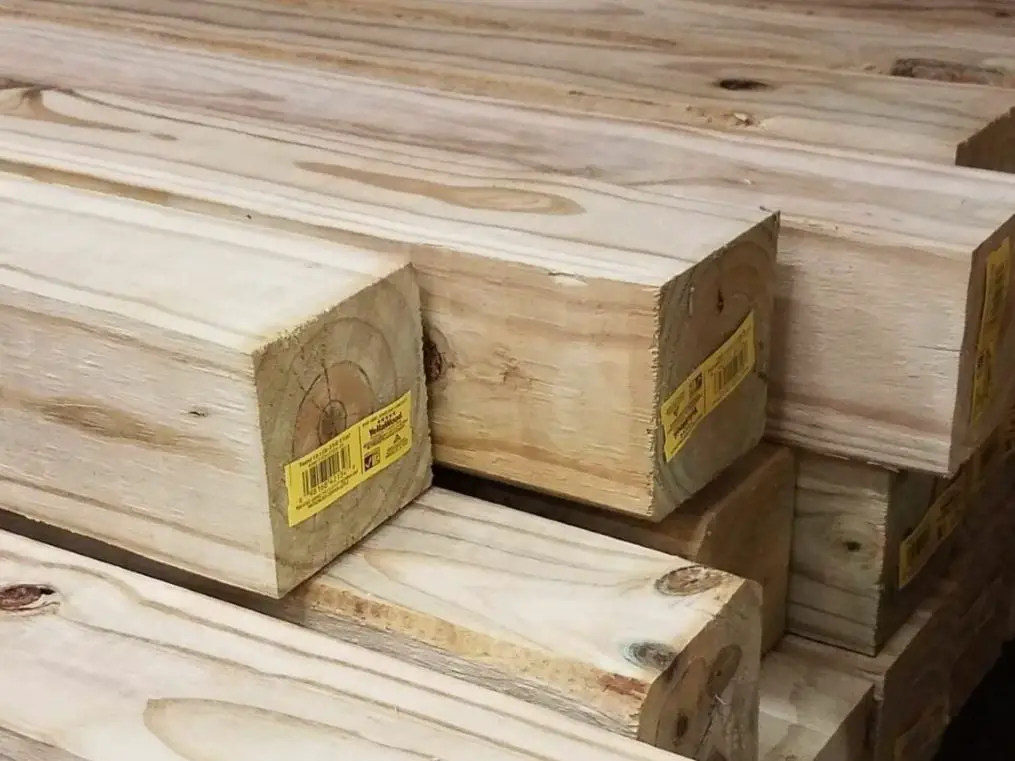Table of Contents

Introduction
Knowing material weights is extremely important when you’re planning on putting things on a roof. You have to avoid loads that exceed the design strength of the roof and the roof’s supporting structure.
I thought it would be helpful to have an easy way to look up the weight of 4×4 lumber, so here it is.
I looked up the densities for the various types of wood used to make dimensional lumber and performed some simple math (I explain the math below after the table) to generate the values used in the calculator and table.
Then I checked the weight values I got against actual product data sheets published by lumber producers and retail stores like Home Depot to make sure my figures were accurate.
The following calculator and table provides the approximate weight (dead load, self-weight) of 4×4s produced from the various wood species and in the various lengths normally used in building construction in the US.
The values given in the calculator and table are meant to provide a general idea of typical 4×4 weights, and should not be used if precise values are needed for critical engineering calculations. The weights are for air-dried lumber; kiln-dried lumber will weigh a little less, and green lumber can weigh a lot more.
When precision is necessary, always refer to the specification sheet for the actual, specific product you intend to use, or contact the technical department of the lumber producer or lumberyard.
You can see 4×4s for sale on the Home Depot or Lowe’s websites. The approximate weights of the actual pieces of lumber for sale are often given in the product descriptions, so this can be a pretty good resource.
For the weights of lumber with different dimensions, see my Dimensional Lumber Weight article.
4×4 Lumber Weight Calculator
This calculator uses the data from the table below.
4×4 Weight Factors
4×4 lumber weight depends chiefly on the length of the board, the moisture content of the wood, and which tree species the lumber was made from. Pressure-treating the wood with preservative will also result in a small amount of additional weight after the board has had time to dry out after the treatment process.
Board Length: The length of the 4×4 will obviously be the biggest factor in determining 4×4 weight. This is self-explanatory.
Moisture Content: The moisture content of the wood is a big factor as well, but since all lumber tends to eventually arrive at the air-dried moisture content, variations in moisture content can be considered a temporary consideration.
Green lumber has a higher moisture content than air-dried lumber, and air-dried lumber has a higher moisture content than kiln-dried lumber.
Green lumber has a moisture content above 19%. Depending on the actual moisture content of a particular piece of lumber, which can be well above 100% due to the way the moisture content of wood is calculated, a piece of green lumber can be more than 50% heavier than the same piece of lumber when air-dried.
The typical weight of green lumber is roughly 10% to 30% more than the dried weight of lumber made from the same wood species.
Kiln-dried wood will normally start with a somewhat lower moisture content than air-dried wood, but it tends to slowly absorb enough moisture from its environment to eventually reach the same moisture content as air-dried wood in the same environment.
Wood Species: The wood species the lumber comes from is the third important variable in determining 4×4 weight. A 10-foot-long air-dried 4×4 made out of Douglas Fir (coast type) will weigh about 29 pounds. A 10-foot-long air-dried 4×4 made out of Sitka Spruce will only weigh around 24 pounds.
Pressure-Treatment: Pressure-treated 4×4’s are notoriously heavy at the time that people buy them. This is because when you find them in the store, they are usually freshly-treated, or have only had time to dry for a couple of weeks or less.
The water weight added to the wood during the pressure-treating process leads to freshly-treated boards weighing up to 75% more than the weight of untreated boards immediately after being treated. This weight is temporary. The board will return (almost) to its original weight as it air-dries during the weeks or months after treatment.
4×4 weight for treated wood will be approximately 0.4% to 1.5% more than the 4×4 weight for untreated wood from the same tree species after drying.
Actual Dimensions of a 4×4
A 4×4 is not four inches by four inches in cross section, despite what it’s called. 4″ x 4″ are the nominal dimensions of the board.
The actual dimensions of a 4×4 are 3.5″ x 3.5″. Here’s why that is:
When a board is first milled, it actually will have the approximate width and depth (the nominal dimensions) that the final piece of lumber will be known by.
After the first rough cut, a four-by-four is, in fact, about four inches by four inches.
The next step in the milling process is to either air-dry or kiln-dry the green lumber, in order to reduce the moisture content of the wood. This causes the boards to shrink, reducing the actual dimensions. One reason this is done is to ensure that when the lumber is finished and sold its dimensions will be stable, and it won’t continue to shrink after somebody buys it.
After drying, the boards are finished by being planed and smoothed, and having their corners slightly rounded.
This reduces the actual dimensions even further; it also lets the lumber producer be certain that the final product has the dimensions required by industry standards. In the case of a 4×4, this industry standard is 3.5″ x 3.5″.
How to Calculate 4×4 Weight
Step 1: Determine the wood type. To determine 4×4 lumber weight, you need to know what kind of wood the 4×4 is made from.
Step 2: Look up the density of the wood. Once you know what type of wood you’re dealing with, look up the density of the wood in pounds per cubic foot. Weights of Various Woods Grown in the United States has an extensive table of wood species you can refer to, or there are plenty of other resources on the internet with the same information.
Step 3: Calculate the volume in cubic inches of a one-foot-long 4×4. This value will be used to figure out what percentage of a cubic foot a one-foot-long 4×4 is. Since a 4×4 is 3.5 inches by 3.5 inches, a one-foot-long 4×4 will have a volume in cubic inches of 3.5 x 3.5 x 12, or 147 cubic inches.
Step 4: Find what percentage of a cubic foot the volume of a one-foot-long 4×4 is. A cubic foot is equal to 12 inches x 12 inches x 12 inches, or 1,728 cubic inches. A 4×4 is 147 cubic inches per foot. 147 is 1/11.7551 of 1,728, or 8.5069% of a cubic foot (147/1728 x 100 = 8.5069).
Step 5. Find 8.5069% of the density in pounds per cubic foot of your 4×4 wood species. Let’s say you’re trying to figure out the weight of a 4×4 made out of a type of southern yellow pine (loblolly pine, for example). You look up the density of white fir and see that it’s 38 pounds per cubic foot. Multiply 38 pounds by 0.085069 to get 3.232622 pounds. (We’d round this to 3.23 to be practical.) This is the weight per foot of a 4×4 made from loblolly pine.
Step 6: Multiply by the length of the 4×4. If your 4×4 is 6 feet long, multiply 6 by 3.23 to get 19.38 pounds.
And there you go, a 6-foot loblolly pine 4×4 weighs 19.38 pounds.
Table: 4×4 Weight by Wood Type and Length
| 4×4 Lumber Weight by Wood Type and Length | ||||||||
|---|---|---|---|---|---|---|---|---|
| (Average Dry Weight, 12% Moisture Content) | ||||||||
| Type of Wood | Length of 4×4 in Feet (4 × 4 × number of feet) | |||||||
| These are the most common wood types used in construction in North America. | Weight Per Foot (4x4x1) in Pounds |
4x4x6 | 4x4x8 | 4x4x10 | 4x4x12 | 4x4x14 | 4x4x16 | |
| Pressure Treated Wood | Pressure-Treated (Freshly Treated) | 6.21 lb | 37.26 lb | 49.68 lb | 62.10 lb | 74.52 lb | 86.94 lb | 99.36 lb |
| Pressure-Treated (After Air Drying) | 3.49 lb | 20.94 lb | 27.92 lb | 34.90 lb | 41.88 lb | 48.86 lb | 55.84 lb | |
| Cedar | Western Red Cedar | 1.96 lb | 11.76 lb | 15.68 lb | 19.60 lb | 23.52 lb | 27.44 lb | 31.36 lb |
| Douglas Fir | Douglas Fir (Coast Type) | 2.89 lb | 17.34 lb | 23.12 lb | 28.90 lb | 34.68 lb | 40.46 lb | 46.24 lb |
| Douglas Fir (Mountain Type) | 2.55 lb | 15.30 lb | 20.40 lb | 25.50 lb | 30.60 lb | 35.70 lb | 40.80 lb | |
| Fir | Noble Fir | 2.21 lb | 13.26 lb | 17.68 lb | 22.10 lb | 26.52 lb | 30.94 lb | 35.36 lb |
| Subalpine Fir | 2.81 lb | 16.84 lb | 22.46 lb | 28.07 lb | 33.69 lb | 39.30 lb | 44.92 lb | |
| White Fir | 2.21 lb | 13.26 lb | 17.68 lb | 22.10 lb | 26.52 lb | 30.94 lb | 35.36 lb | |
| Hemlock | Mountain Hemlock | 2.81 lb | 16.86 lb | 22.48 lb | 28.10 lb | 33.72 lb | 39.34 lb | 44.96 lb |
| Western Hemlock | 2.47 lb | 14.82 lb | 19.76 lb | 24.70 lb | 29.64 lb | 34.58 lb | 39.52 lb | |
| Larch | Western Larch | 3.06 lb | 18.36 lb | 24.48 lb | 30.60 lb | 36.72 lb | 42.84 lb | 48.96 lb |
| Pine | Lodgepole Pine | 2.47 lb | 14.82 lb | 19.76 lb | 24.70 lb | 29.64 lb | 34.58 lb | 39.52 lb |
| Ponderosa Pine | 2.38 lb | 14.28 lb | 19.04 lb | 23.80 lb | 28.56 lb | 33.32 lb | 38.08 lb | |
| Southern Yellow Pine (Loblolly) | 3.23 lb | 19.38 lb | 25.84 lb | 32.30 lb | 38.76 lb | 45.22 lb | 51.68 lb | |
| Southern Yellow Pine (Longleaf) | 3.49 lb | 20.94 lb | 27.92 lb | 34.90 lb | 41.88 lb | 48.86 lb | 55.84 lb | |
| Southern Yellow Pine (Shortleaf) | 3.23 lb | 19.38 lb | 25.84 lb | 32.30 lb | 38.76 lb | 45.22 lb | 51.68 lb | |
| Southern Yellow Pine (Slash) | 4.08 lb | 24.48 lb | 32.64 lb | 40.80 lb | 48.96 lb | 57.12 lb | 65.28 lb | |
| Spruce | Engelmann Spruce | 1.96 lb | 11.76 lb | 15.68 lb | 19.60 lb | 23.52 lb | 27.44 lb | 31.36 lb |
| Sitka Spruce | 2.38 lb | 14.28 lb | 19.04 lb | 23.80 lb | 28.56 lb | 33.32 lb | 38.08 lb | |
| White Spruce | 2.38 lb | 14.28 lb | 19.04 lb | 23.80 lb | 28.56 lb | 33.32 lb | 38.08 lb | |
SPF (Spruce-Pine-Fir) Lumber
Spruce-pine-fir (SPF) lumber is typically considered one product and it’s often used for dimensional lumber. The properties of spruce, pine, and fir lumber are close enough for them to be considered interchangeable for construction purposes. This means that when you buy lumber for framing or similar structural purposes you are likely to get a mixture of wood species from these three tree genera.
The weight of SPF lumber is therefore an average weight that can change depending on the actual mix of wood species in the particular batch you get. Very generally, the average weight of SPF lumber is usually close to the weight of White Spruce or White Fir.
You can read more about the species used for SPF lumber in this article on the American International Forest Products website.
References for 4×4 Lumber Weight
- American Softwood Lumber Standard – National Institute of Standards and Technology; U.S. Department of Commerce
- Weights of Various Woods Grown in the United States – Forest Products Laboratory, United States Forest Service, USDA
- Wood Handbook, Wood as an Engineering Material – Forest Products Laboratory, United States Forest Service, USDA

